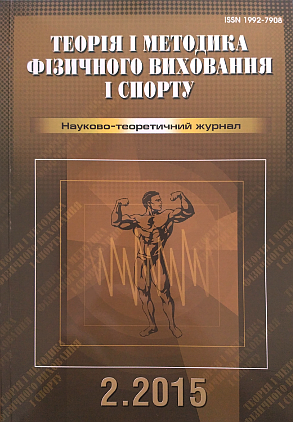Роль рухової активності у фізичній реабілітації хворих із захворюваннями серцево-судинної системи
DOI:
https://doi.org/10.32652/tmfvs.2015.2.101-105Ключові слова:
двигательная активность человека, гипокинезия, сердечно-сосудистые заболевания, кардиологическая реабилитацияАнотація
Рассмотрен вопрос связи между двигательной активностью и сердечно-сосудистыми забо-
леваниями. Показано, что снижение физической активности человека становится причиной развития у него сердечно-сосудистых заболеваний и повышения показателей смертности от этих заболеваний. Предложено использовать различные формы двигательной активности, которые понижают показатели смертности населения от сердечно-сосудистых заболеваний.
Посилання
McGinnis J. M. The immediate vs the important / J. M. McGinnis, W. H. Foege // JAMA. – 2004. – Vol. 291, N 10. – P. 1263–1264.
WHO Physical Inactivity: A Global Public Health Problem. WHO. – [Electronic resource] // Acces mode: http:// www.who.mt/dietphysicalactivity/factsheet_inactivity/en/index.html.
WHO Why «Move for Health». WHO. – [Electronic resource] // Acces mode: http://www.who.int/ moveforhealth/en.
Danaei G. The Preventable Causes of Death in the United States: Comparative Risk Assessment of Dietary, Lifestyle, and Metabolic Risk Factors / G. Danaei, E. L. Ding, D. Mozaffarian et al. // PLoS Med. – 2009. – N 6. – P. 4.
The world health report 2002 — Reducing risks, promoting healthy life. – Geneva: World Health Organization, 2002. – [Electronic resource] // Acces mode: http://www.who.int/whr/2002/ en/.
Thompson P. D. Exercise and physical activity in the prevention and treatment of atherosclerotic cardiovascular disease: a statement from the Council on Clinical Cardiology (Subcommittee on Exercise, Rehabilitation, and Prevention) and the Council on Nutrition, Physical Activity, and Metabolism (Subcommittee on Physical Activity) / P. D.Thompson, D. Buchner, L. Pinal et al. // Circulation. – 2003. – Vol. 107, N 24. – P. 3109– 3116.
Morris J. N. Coronary heart-disease and physical activity of work / J. N. Morris, J. A. Heady, P. A. B. Raffle et al // Lancet. – 1953. – Vol. II. – P. 1053–1057.
Paffenbarger R. S. Work activity and coronary heart mortality / R. S. Paffenbarger, W. E. Hale // N Engl J. Med. – 1975. – Vol. 292, N 11. – P. 545–550.
Myers J. Fitness versus physical activity patterns in predicting mortality in men / J. Myers, A. Kaykha, S. George et al. // Am J. Med. – 2004. – N 117. – P. 912—918.
Jonker J. T. Physical Activity and Life Expectancy With and Without Diabetes / J. T. Jonker, C. De Laet, O. H. Franco et al. // Life table analysis of the Framingham Heart Study. Diabet Care. – 2006. – N 29. – P. 38–43.
Kannel W. B. Some health benefits of physical activity: the Framingham Study / W. B. Kannel, P. Sortie // Arch Int Med. – 1979. – N 139. – P. 857–861.
Sherman S. E. Does exercise reduce mortality rates in the elderly? Experience from the Framingham Heart Study / S. E. Sherman, R. B. D'Agostino, J. L. Cobb, W. B. Kannel // Am Heart J. – 1994. – N 128. – P. 965– 972.
Oertel M. Allegemeine Therapie der kreislaufstorungen / M. Oertel // Allegemeine Therapie der kreislaufstorungen / ed. J. Ziemssen. – Leipzig: Vogel, 1891.
Newman L. B. Physical medicine and rehabilitation in acute myocardial infarction / L. B. Newman, M. F. Andrews, M. O. Koblish et al. // Arch Int Med. – 1952. – N 89. – P.552–561.
Hellerstein H. F. Rehabilitation of the cardiac patient / H. F. Hellerstein, A. B. Ford // JAMA. – 1957. – N 164. – P. 225–231.
Leon A. S. Cardiac Rehabilitation and Secondary Prevention of Coronary Heart Disease / A. S. Leon et al.; An AHA Scientific Statement // Circulation. – 2005. – Vol. lll. – P. 369–376.
Balady G. J. Core components of cardiac rehabilitation/secondary prevention programs: 2007 update: a scientific statement from the American Heart Association Exercise, Cardiac Rehabilitation, and Prevention Committee, the Council on Clinical Cardiology; the Councils on Cardiovascular Nursing, Epidemiology and Prevention, and Nutrition, Physical Activity, and Metabolism; and the American Association of Cardiovascular and Pulmonary Rehabilitation / G. J. Balady, M. A. Williams, P. A. Ades et al. // Circulation. – 2007. – N 115. – P. 2675.
Scrutinio D. Long-term secondary prevention programs after cardiac rehabilitation for the reduction of future cardiovascular events: focus on regular physical activity / D. Scrutinio, P. L. Temporelli, A. Passantino, P. Giannuzzi // Future Cardiol. – 2009. – Vol. 5, N 3. – 297–314.
Global strategy concerning nutrition, physical activity and health. – [Electronic resource] // Acces mode: http://www.who.int/dietphysicalactivity/strategy/eb11344/strategy_russian_web.pdf.
Соntribution to physical activity in order to strengthen health –basis for actions in European region of the WHO. Steps on the way to physically more active Europe. World Health Organization. European Regional Bureau. WHO Regional Office for Europe, Scherfigsvej 8 DK-2100. – Copenhagen (Denmark), 2006. – P. 46.
Squires R. W. Are cardiac rehabilitation programs underutilized by patients with coronary heart disease? / R. W. Squires // Nat Clin Pract Cardiovasc Med. – 2008. – Vol. 5, N 4. – P. 192–193.
Jolly K.The Birmingham Rehabilitation Uptake Maximization study (BRUM): a randomized controlled trial comparing home-based with centre-based cardiac rehabilitation / K. Jolly, G. Y. H. Lip., R. S. Taylor et al. // Heart. – 2009. – N 95. – P. 36–42.
Albert С. М. Triggering of sudden death from cardiac causes by vigorous exertion / С. М. Albert, M. A. Mittleman, C. M. Chae et al. // N Engl J. Med. – 2000. – Vol. 343, N 19. – P. 1355–1361.
##submission.downloads##
Опубліковано
Номер
Розділ
Ліцензія
Авторське право (c) 2017 Теорія і методика фізичного виховання і спорту

Ця робота ліцензується відповідно до Creative Commons Attribution 4.0 International License.

